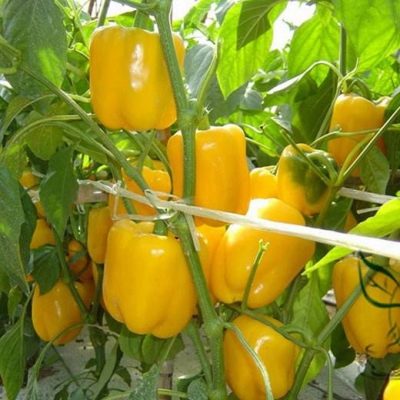
- Authors: Maksimov S.V., Klimenko N.N., Kostenko A.N.
- Year of approval: 2008
- Bush height, cm: up to 80
- Growth type: medium-sized
- Fruit shape: prismatic
- Fruit weight, g: 120-170
- Fruit color: green in technical ripeness, yellow in biological ripeness
- Ripening terms: late ripening
- Ripening month: July August September
- Fruit size, cm: length 10-11
Sweet pepper Yellow bell has a self-explanatory name - the variety is so named because its beautiful presentation fruits are very reminiscent of inverted bells. In addition, it is famous for its excellent taste, usefulness, and unpretentiousness. All these qualities made the Yellow Bell a welcome guest on Russian beds and greenhouses.
Breeding history
The yellow bell is the fruit of the selection work of the Poisk agrofirm and its employees Maksimova S., Klimenko N. and Kostenko A. The work was completed in 2006, and after 2 years, in 2008, the variety was approved for use in open beds and under the film of personal subsidiary plots. Zoning covers almost the entire territory of the Russian Federation.
Description of the variety
The late-ripening variety Yellow bell has a universal purpose, it is able to set fruits even with changes in air temperatures. It differs in a cuboid shape of the fruit, and the already ripe and harvested crop is perfectly transported over long distances. Peppers also have a good keeping quality.
Characteristics of the appearance of plants and fruits
The plant is of medium height, the bush grows up to 80 centimeters, is semi-spreading, relatively compact. Good foliage. Slightly wrinkled leaf plates are also medium in size, colored green.
The fruits hang on the branches drooping, the shape is prismatic (cube). Peppers are glossy, beautiful, colored during the period of technical ripeness with a delicate light green color, at the stage of biological maturity - a bright yellow color. The number of chambers is from 2 to 3. The weight of one pepper is 120-170 grams, its walls are 4.5-5.2 mm thick.
Purpose and taste
The taste of fresh peppers of the Yellow Bell variety is considered by many to be excellent, with a juicy pulp, without the slightest bitterness. It is a versatile product for its intended purpose. It is recommended to use it both fresh, for salads, snacks, and for home cooking, such dishes as lecho and stuffed peppers are especially tasty. Ripe yellow bright fruits are often used to decorate ready-made dishes. They add it to hot dishes, use it for canning, various preparations, and freeze it.
Ripening terms
Late-ripening variety Yellow bell ripens in July. Long-term fruiting, up to September.
Yield
The yield of the Yellow Bell is at the highest level, on average, from 1 square meter, you can get 8 kilograms of bright and beautiful fruits.
Landing scheme
It is recommended to plant plants in a garden bed or in a greenhouse according to the 40x60 centimeters scheme.

To get a large and tasty harvest of pepper, you need to take care of the seedlings in advance. When growing pepper seedlings, you need to correctly determine the sowing time, pre-sowing seed treatment, prepare the necessary container and soil.
Growing and caring
It is advisable to choose a site for planting seedlings of the considered pepper culture one that will be well lit by the sun's rays, and also sheltered from drafts and gusts of wind. The soil for growing Yellow Bell pepper should be fertile, loose, it is better if it is sandy loam or loam. Heavy clay can be improved by adding humus or compost, sawdust, but only rotted, coarse sand.
The transfer of the grown seedlings to the place of growth can be done only when the weather is rather warm. In case frosts are still expected, arched metal structures can be installed over the ridges, onto which a non-woven covering material should be stretched. Such an impromptu greenhouse will be able to protect young shoots from temporary cold weather.
In the future, peppers need to be watered regularly, namely every 3-4 days. If the weather is rainy, the amount of irrigation is adjusted. The liquid is needed only warm and settled. Water is brought under the root so that it does not fall on the stems and leaves.

To harvest a tasty and rich harvest of pepper, you need to comply with all the conditions of agricultural technology, and proper care begins with planting plants. Before planting pepper in open ground, it should be prepared. It is also important to take care of the seedlings and planting space in advance.




For good growth of pepper bushes and active fruiting, you need to regularly apply mineral and organic fertilizing to the soil. It is necessary not only to choose the right formulations, but also to use them at the right stage in the development of culture. The frequency of top dressing is always individual. It depends directly on the composition of the land on your site. The poorer the soil composition, the more often you will need to feed the pepper.
Disease and pest resistance
The yellow bell pepper variety has a fairly strong immunity, is resistant to various ailments, especially to the tobacco mosaic virus.

Pepper is one of the most common vegetables in home gardens. This culture is quite stable and unpretentious. However, under certain conditions, this plant can suffer from infections and harmful insects. Before treating peppers for diseases or pests, you need to find out the cause of the problem, otherwise the treatment may be ineffective.





















































































